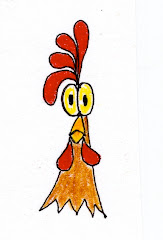Dateline: 25 April 2015
 |
| Raised beds in my 2014 garden. (click on pictures to see enlarged views) |
Most how-to articles or YouTube videos on the subject of making raised beds in the garden focus on using lumber or concrete blocks to frame the beds. I have made and grown food in lumber-framed raised beds in years past, but not any more. These days I make simple raised beds as I explain in this blog post...
My raised beds are all 30" wide and 16' long, with an 18" walkway between them.
I have made wider and longer raised beds, but this size is one that works well for me. The bed and walkway width is the same as used by Jean-Martin Fortier in his excellent book, The Market Gardener (which I reviewed HERE), but his beds are 100' long.
After cultivating the garden soil, I stake out the beds, using wood stakes cut from old pallets...
 |
| the stakes are 18" long |
The stakes are driven into the soil with a sledge hammer...
A standard shovel is 9" wide. The walkway between the beds is 18." See how nice that works out?....
 |
| The red metal in the background is recycled sheet metal siding that I have laid down as a walkway in my garden. |
I use polypropylene baling twine, tied from stake to stake to outline my garden beds and walkways. Polypropylene twine is very strong and does not sag after being stretched tight...
This next picture shows the strings in place, framing what will be a walkway between two beds...
With stakes and strings in place, it is time to start making the raised beds. I do this by working my way down the 18" walkway and "excavating" one shovel-width of soil onto the bed on the right, as this next picture shows...
 |
| I am shoveling the loose soil, down 4" or 5" onto the bed. |
This next picture shows the right half of the walkway has been shoveled onto the raised bed on the right, and I am about to shovel down the left side, putting the soil onto the left raised bed....
Once that is done, the walkway and raised beds will look like this...
And here you can see two walkways shoveled out, with a raised bed in the center...
Now it is time to shape the raised bed. I do this with a garden rake. This next picture shows the bed is shaped in the foreground, and has yet to be shaped in the background...
And here is the whole bed after being shaped with the garden rake...
I take this shaping and finishing of the bed a step further by using a leaf rake...
 |
| The smoothed and finished bed is in the background. The small rubble in the foreground is what the rake collects. |
Here you can see a finished bed, ready for planting...
This next picture shows three beds all shaped and smoothed. A Planet Whizbang wheel hoe can be used to keep the beds cultivated and free of weeds. I've used my wheel hoe for this purpose in the past, but I now use black plastic mulch in the walkways.
The strings and stakes stay in place for the entire gardening season. In my next installment of this series, I will show how I am using black plastic as a mulch in the walkways between the beds. I have a new way of easily securing the plastic.
###
Click Here to go to Part 2 of this garden bed how-to series.

































































































































16 comments:
Thank you for the raised bed post Herrick. I've been growing in raised beds since the late 1970's. I basically build them the same way as you but I find that a scoop or even better, a spade, works better than a shovel but all will do. My beds are basically permanent and just last year I pulled some soil out of the walkways to build them back up a bit. I started using landscape fabric last year in the walkways and it was great not worrying about weeds or excess straw. I'm interested in your method of securing - landscape pins are a 50-50 proposition on whether they'll stay.
BTW, in that first picture what is planted with the kale? I can't tell if it's lettuce or bok choi or what and what spacing do you use - that looks like a very nice, dense planting. Thanks.
Okay, I'll take a guess and say Romaine lettuce?
Hi, ordered your book yesterday! Do you have a similar post on Strawberry beds?
Thanks, Paul
vdeal—
You are correct with your (educated) guess. It is Romaine lettuce. I don't recall the spacing. Hopefully, I wrote it down in last year's notes, because it was a good spacing.
I consider these beds to be permanent. The beds I made last year, to these same specifications, will work just fine this year, and for years to come. I may shallow-hoe the surface a bit and re-shape the beds a little with a rake, but the major work is done. I'm putting more of my "flat" garden into raised beds exactly as shown here.
Hi Paul—
Thanks for buying a copy of my book. Be sure to check out the "hidden" web site I've created for readers of the book (see page 124 for directions). It has pictures of "hugelberry" strawberry beds. I have not posted pictures of strawberry beds on this blog. However, I will be planting three raised beds (like shown here) with strawberries this year. They will not be hugelberries and it will be interesting to see if they can come close to the enormous E.P. Roe, summer-planted Hugelberries.
I make my garden beds the same way. I may put up stakes and string but I definitely will be getting some plastic like you do. I am curious though. If you cut holes in your plastic, you must intend to reuse them with the same crop the following year.
I can't wait for the next installment. Pictures are a tremendous boon to the written word.
Pam
Your beds look right out of a magazine. I'm going to make mine of straw sides so as to have some ready compost at the end of the season to add in. I recently attended a lecture at the Mother Earth Fair on raised beds entitled "How to get 6" of soil in 6 months w/ 600,000 bugs". I've done the double dug method in the past & it's evident how much work went into such a few pictures. I appreciate this series, thanks.
Mrs. V,
I've backed way off on the straw. I doesn't really break down that fast over a season or a few seasons laying on the soil. At the end of the season you'll still have straw and not compost. BTW, my beds aren't double dug and I'm pretty sure Herricks' aren't either. I did that double dug thing once back around 1978 or 79 and that was enough. Honestly, I think it inverts the soil layers too much and disrupts the microfauna of the soil. Now, if you like doing that, that's all well and fine but I'll stick with my method.
Your method of raised beds looks great, Herrick; a bit similar to Old Country Gardens in Ohio, and also Mittleider grow beds. My question: What do you do about gophers & moles? I have had to line all my raised (wood or blocks) beds with 1/2 inch hardware 'cloth'. Otherwise, my underground residents help themselves. We keep deer out with a 7' fence, and jackrabbits are not yet a problem in our Sierra foothill garden.
I like it! This is how Martha Stewart does her beds, too. She changes them around from year to year. Or at least, at the time that I was watching her videos and reading her gardening book she was. She was the only one I had read that didn't have permanent raised beds with some kind of wall around the beds.
I wouldn't have thought to keep the strings and stakes all year. Interesting.
Do the paths stay soggy since you dig down? Do your beds change position from year to year?
Thanks - you turned us on to Gardening When It Counts by Steve Solomon a few years ago - he does his beds this way. I also bought the Market Garden on your recommendation and like the use of standard sizes to accommodate tools and plastic ground cover. I might try the plastic - it'd be nice but could be too expensive. Wonder if I could somehow repurpose woven plastic feed sacks for the walkways. It'd be hard to stake 'em down tho -
Kind Regards - Muns
Hi Pam—
I am using two different kinds of plastic mulch in my garden now. The light, inexpensive, one-year kind and the heavy, expensive, multi-year-lifespan plastic. If I make planting holes in the expensive material I will surely be using it again.
Mrs. V—
Part of the fun of gardening is trying new ideas and figuring out what works best for you. Have you priced straw bales? I've seen them as high as $7.50 each around here.
Anonymoous—
You have critter problems that I pretty much don't have, except that last year I had a lot of rodent-gnawed sweet potatoes at harvest time. That was a first, and very discouraging.
Sharon‚
I have changed my garden around quite a bit in years past, looking for a bed/planting system that suites me. I'm pretty certain that this size and system of permanent raised planting beds is what I'm going to use for the rest of my gardening days. I'm converting more of my garden to these beds this year. I'm to the point where I don't have the time or physical stamina to do the epic garden rearranging and changing that I've done in the past.
Muns—
Yes, this bed-making technique is pretty much Steve Solomon's way of getting the job done. His book is still my favorite gardening book and it influenced me a greatly. Standard sizes make a LOT of sense when it comes to reusable plastic mulch. The high-quality plastic is too expensive but I've bought more of it this year. One inexpensive (free) alternative is to get some plastic lumber covers from a lumberyard. Someone commented on my YouTube video that they use these and they last a few years.
Hope you have considered the possible trouble with your black plastic. Not really good for the soil and maybe not really good for you. Cf. following quote from Rodale:
• Phase out plastic mulch. Some gardeners swear by black plastic mulch because it warms the soil and keeps weeds down. The problem is, it could also release chemicals into your soil as the sun beats down on it day in and day out. Beyond that, it's not helping to boost beneficial soil microorganism populations like other natural mulches would, and the impervious plastic surface could create runoff problems.
The bottom line? Rely on untreated grass clippings or organic straw as the best organic mulch options.
Thank you for this detailed breakdown of growing in raised beds. As an avid grower in beds, I have struggled with sizes of raised beds and have often gone far too large. I aim to try your guidance. It's interesting to read the guidance on the type of twine as I have previously used a twine that did not retain its tautness.
Bert Aguilar @ Rainfill Tanks and Curved Roofing Supplies
asd
Post a Comment